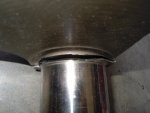See how the break follows an almost perfect radius in the middle and then goes jagged at the left and right side? Where the jaggedness starts, there is a slight rub mark on the fillet.
And no, the initiation point is not square in the middle. It is offset several degrees off center. They all are.
The high stress point depends on where the loads are being applied to the cranks. And the loads are not equal or static. They also have a harmonic factor to them.
And no, the initiation point is not square in the middle. It is offset several degrees off center. They all are.
The high stress point depends on where the loads are being applied to the cranks. And the loads are not equal or static. They also have a harmonic factor to them.



